By Mike Darwin
In Pursuit of a Medical Model for Cryonics
When I returned to Indianapolis, Indiana from working with the Chamberlains in 1975, a high priority for me was to acquire the equipment and expertise required to integrate extracorporeal medicine into cryonics. This proved much more difficult than I had hoped. To a man, all of the emerging professional perfusionists I contacted were uninterested in cryonics, or were actively hostile to it. Nevertheless, I managed to acquire training and employment as an acute care (ICU) hemodialysis technician, and this provided entre’ to both experimental perfusion (the hospital where I worked at the time was gearing up to begin a heart transplant program) and, just as importantly, several sources of used medical equipment.
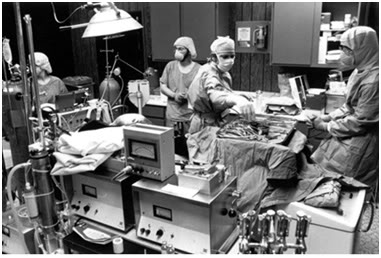 Figure 6: Facilities of Soma, Inc., in Indianapolis, IN in 1980.
Figure 6: Facilities of Soma, Inc., in Indianapolis, IN in 1980.
By 1979 I had managed to acquire roller pumps, gas anesthesia equipment, an electrocautery, a fairly complete set of cardiothoracic surgical instruments, a re-useable Sarns Torpedo heat exchanger, and all the ancillary equipment required to carry out experimental perfusion of dogs and small mammals such as rabbits. Additionally, a patient Transport vehicle and the necessary heart-lung resuscitation equipment had been acquired, as well as the necessary laboratory equipment and cool down and temporary storage gear.8
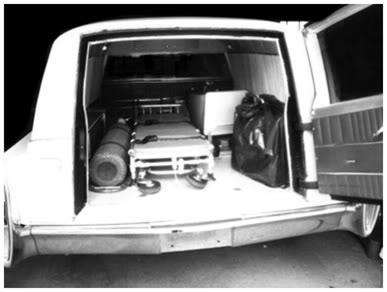
Figure 7: Soma Inc., Transport vehicle, 1977.
 Figure 8: Soma, Inc., Heart-Lung Resuscitator, 1977.
Figure 8: Soma, Inc., Heart-Lung Resuscitator, 1977.
Enter Jerry Leaf
While I was working to both learn and acquire extracorporeal medical capability for cryonics in Indiana, a new figure entered the cryonics scene; Jerry D. Leaf, a perfusionist and Research Associate in the laboratory of Dr. Gerald D. Buckberg, in the UCLA Department of Thoracic Surgery. Jerry had originally become interested in cryonics after attending a lecture given by Robert F. Nelson, President of the Cryonics Society of California in 1966. In 1977, while Jerry was working at UCLA, he heard about and subsequently attended a cryonics meeting sponsored by Trans Time, Inc., (TT) of Berkeley, CA which had recently merged with Manrise Corporation.9 Later that year, Jerry performed a canine total body washout (TBW) in collaboration with TT, with the dog surviving for 17 hours after complete blood replacement and asanguineous perfusion at 22oC.10 Through TT, Jerry became acquainted with the Chamberlains, and shortly thereafter, Alcor collaborated with Jerry to cryopreserve a dog using the same techniques then being employed on humans, with the endpoint being evaluation of brain histology and ultrastructure by transmission electron microscopy (TEM).
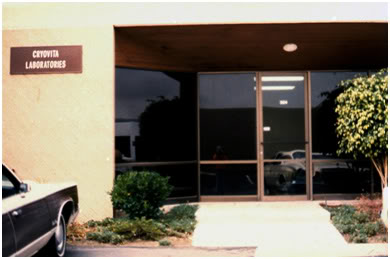 Figure 9: Cryovita Laboratories in Fullerton, CA.
Figure 9: Cryovita Laboratories in Fullerton, CA.
Jerry was acutely interested in improving, and ultimately perfecting reversible cryopreservation, and he was in the process of accumulating equipment to open his own research and development laboratory at the time he first became involved with TT and Alcor. In 1978 he opened Cryovita Laboratories, Inc., in Fullerton, CA and Cryovita cryopreserved its first patient, Samuel Berkowitz, in July of 1978. It was around this time that Jerry and I made contact with each other and began a long distance working relationship. Despite my best efforts, I had been unable to find a heart-lung machine, and Jerry undertook to locate an ancient, but still serviceable PAR machine from the early 1960s, which he shipped to me in Indianapolis in1979.
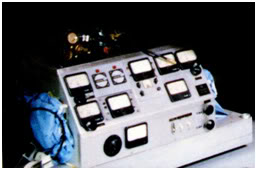
Figure 10: The PAR heart-lung machine shortly after its arrival in Indianapolis, in 1979.
Samuel Berkowitz was the first cryonics patient treated using then standard extracorporeal technology and vascular access via the aortic root and right atrium (median sternotomy). This case was well documented in an article (with accompanying photos) published in Long Life magazine in April of 1979.11 I’ve selected some photos from Jerry’s case file on this patient, and I reproduce them here to document that as of 1978 extracorporeal medical technology was in use in cryonics in Southern California with both Alcor and Trans Time being paying consumers for the product.
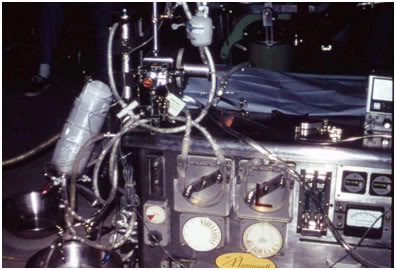 Figure 11: The heart-lung machine set-up to deliver cryoprotective perfusion at Cryovita Laboratories in July of 1978.
Figure 11: The heart-lung machine set-up to deliver cryoprotective perfusion at Cryovita Laboratories in July of 1978.
The heart-lung machine Jerry had was a prototype unit made by Marquardt Aircraft Company in the early 1960s when they were considering entering the medical device market. While Marquardt decided not to enter the CPB market, they did create a division to manufacture dialysis hardware and consumables – a company that ultimately became LifeMed – a major supplier of hemodialysis consumables in the 1970s and ‘80s. The oxygenator in the photo above was a Bentley Q-100 bubbler.
 Figure 12: Out with old and in with new: Jerry Leaf with the Manrise perfusion machine, circa 1979.
Figure 12: Out with old and in with new: Jerry Leaf with the Manrise perfusion machine, circa 1979.
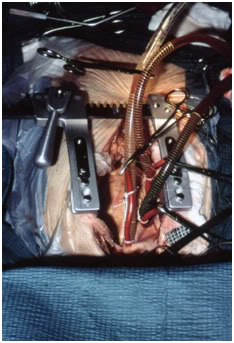 Figure 13: Median sternotomy with arterial and venous cannulae in place in cryopatient Samuel Berkowitz in 1978.
Figure 13: Median sternotomy with arterial and venous cannulae in place in cryopatient Samuel Berkowitz in 1978.
Before Mr. Berkowitz could be positioned on the operating table (OR), the Orange County Coroner, accompanied by the Fullerton Police, showed up at Cryovita and demanded entry. A neighbor had seen the mortuary air shipping container being unloaded into the premises and had called the police.
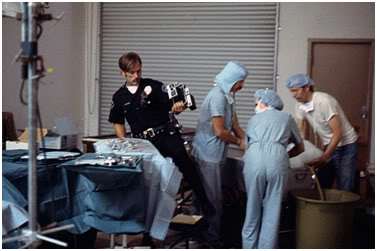
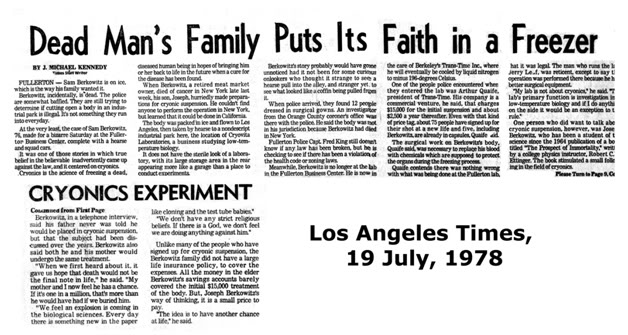 Figure 14: The Fullerton police (top) in the Cryovita facility in July of 1979 photographing the patient and the premises and an article describing the incident which subsequently appeared in the Los Angeles Times.
Figure 14: The Fullerton police (top) in the Cryovita facility in July of 1979 photographing the patient and the premises and an article describing the incident which subsequently appeared in the Los Angeles Times.
After some phone consultation with the California State Department of Health Services, and calls to the next of kin, the police and Coroner left the premises and Mr. Berkowitz’s cryopreservation proceeded to completion without incident.
End of Part 2
References
8) Dewey, P. Interview with Mike Darwin, Long Life Magazine: A Journal of the Life Extension Sciences. 4(2):March/April;32-37:1980, p. 36: http://cryoeuro.eu:8080/download/attachments/425990/LongLifeMag4%282%2917_1980.pdf. Retrieved 2011-01-24.
9) Darwin, M, Interview with Jerry Leaf, Part I. Cryonics. 7(7);26-34:1986. http://www.alcor.org/Library/html/Interview-JerryLeaf.html. Retrieved 201-02-24.
10) Leaf, JD. A pilot study in hypothermia using femoral-femoral-jugular bypass and total body washout. Long Life, Nov-Dec 1977, pp 135-140.
11) Leaf, JD. Cryonic Suspension of Sam Berkowitz: Technical Report. Long Life. Mar-Apr, 1979, pp 30-35. http://cryoeuro.eu:8080/pages/viewpageattachments.action?pageId=425990&sortBy=date&highlight=Berkowitz_Cryopreservation_Report_Mar_Apr_1979.pdf&. Retrieved 2011-01-24.
